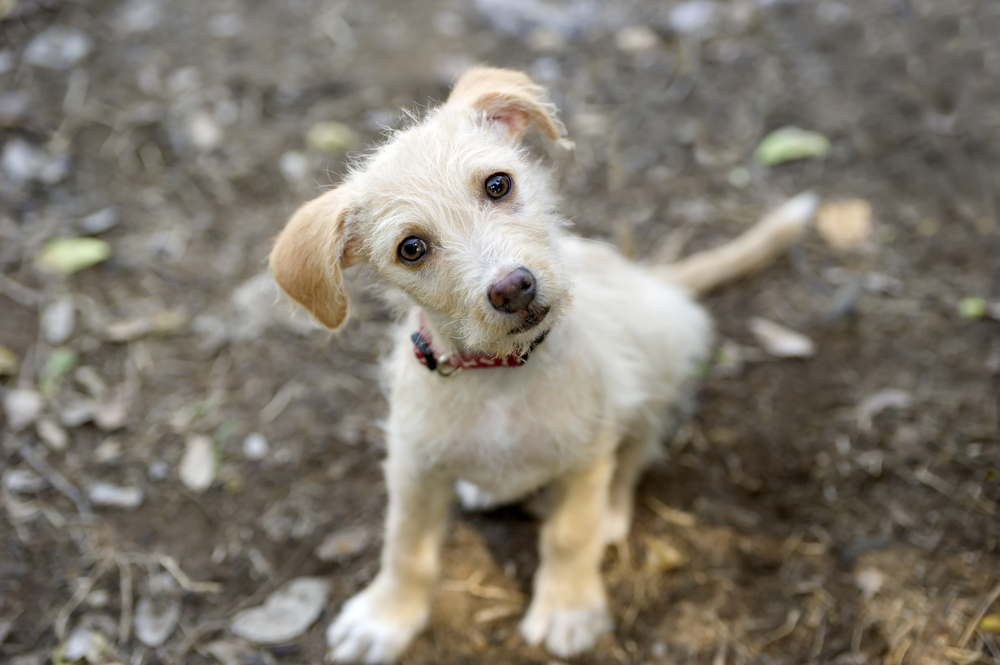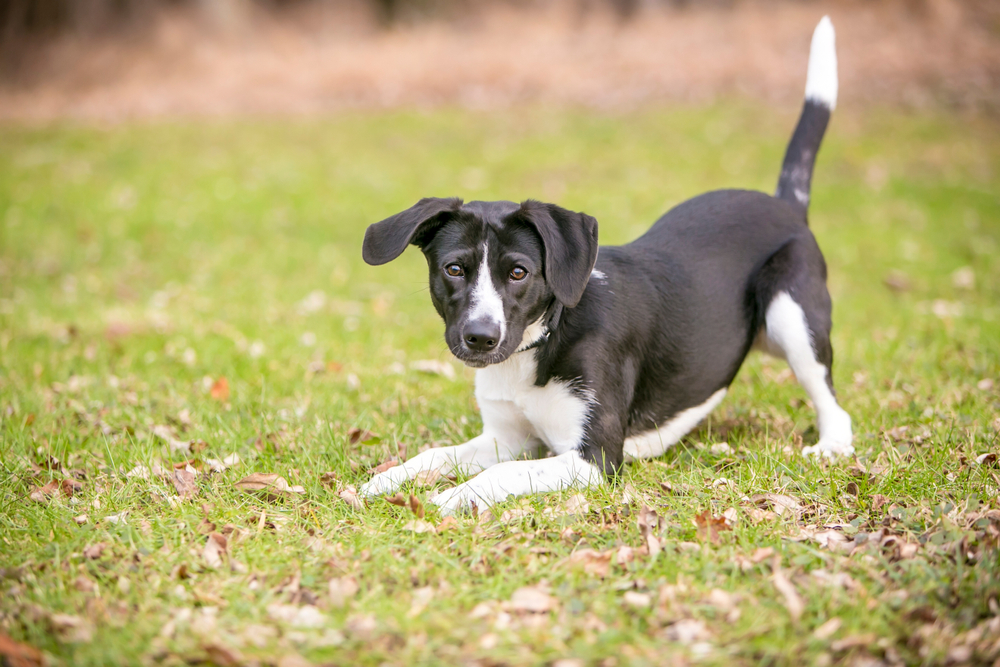From bounding up to greet you after work to jumping in bed to wake you up in the morning, our dogs’ happy moments often come with plenty of tail wags. Far from just communicating their overwhelming joy for your presence, however, those wags can also tell us a lot about how dogs react to their environment.1
Often, those tail wags can simply be a sign they’ve spotted another canine friend or are excited about dinner or treats like CBD for dogs. But what if those dog tail signals are trying to tell you something else?
In truth, our dogs’ tails can express a whole range of emotions—and happiness is just the start. Learning how to read your pup’s tail wags and body language can help you stay in tune with their needs and feelings, no matter the situation. To that end, let’s dive into the 7 most common types of tail wagging.
#1 The Joyful Tail Wag
You walk in the door after a day away and your dog gallops up to you, tail slightly raised and wagging at a moderate speed. It’s a wag that automatically inspires all the pets and praises, and for good reason.
As much joy as this kind of tail wag can bring you, this relaxed but speedy wag often signals joy and happiness in your dog, too.
Usually, the situation you’re in can help you determine whether a dog’s wag is truly a happy one. If you’re in a comfortable, familiar environment, your dog may feel more relaxed and cheerful than they would elsewhere.
Other signs of your dog’s happy mood may include:2
- Hips and shoulders that gently move side-to-side with their tail
- Relaxed, wiggly posture
- Floppy ears
- Soft eyes
In the case of a happy wag, all you need to do is give your pup all the attention they deserve, soak up all the joyful energy, and throw in a “good dog” while you’re at it.
#2 The Excited Tail Wag
Perhaps they know something’s about to happen the moment you put on your shoes. Or maybe your dog perks up when they hear you say, “Want to go for a walk?” Whatever triggers the excited tail wag, it’s a sign that your dog thinks something amazing is coming their way.
The excited wag essentially looks like an intensified happy wag. Some signs you might notice include:3
- A tail-wagging speed that increases with the excitement
- A tail that “helicopters” or wags in a circle
- A whole-body movement from side to side
- Your dog hopping or jumping up and down with enthusiasm
An excited wag can bring a whole lot of exuberance. If your dog has trouble calming itself down in the midst of all their enthusiasm, however, you may want to offer them some reassurance. You can do this by petting them, using calming words, or offering them a pet treat that helps them relax, such as a hemp CBD dog biscuit.

#3 The Curious Tail Wag
From sniffing every tree and garbage can they pass to watching another pup across the street, our dogs can seem to have limitless curiosity—and their tail wag shows it, too.
A curious tail wag usually presents as a horizontal tail that slightly moves from side to side.4Other signals of your dog’s curiosity may include:
- Widened eyes
- Forward-pointing ears
- An upright posture, sometimes leaning slightly forward
- A closed mouth and smooth nose and forehead
This tail wag doesn’t necessarily mean that your dog is happy, afraid, or upset. Instead, it signals that they’re thinking about checking something out or waiting to see what will happen.
Depending on the situation, you can encourage your dog’s curious nature or direct their attention elsewhere. To keep your dog curious and happy, try these dog enrichment ideas to keep them engaged!
#4 The Aggressive or Threatening Tail Wag
We often think of tail wagging as a sign of happiness, but dogs can use their tail and body language to show not-so-happy emotions, too. A dog that feels upset, aggressive, or stressed may use their tail to express those feelings and show other people and animals that they mean business.
An aggressive wag usually includes a stiff tail that points upward or that even arches over the dog’s back. 4Their tail might wag or shake slightly from side to side, and your pup may have raised or bristled hair.
An aggressive dog may exhibit other signs as well, such as:
- Ears that point forward and slightly to the side
- Raised hackles, or hair, along their back
- A wrinkled nose and forehead
- A mouth curled to show teeth
- A forward-leaning posture
- Barking or growling
If you see these signs in your dog, try to determine what is causing them to feel stressed or aggressive. You may be able to reassure them to alleviate those feelings. If you spot other dogs around you showing the same aggressive tail wag and posture, however, it’s a good idea to keep your distance.
#5 The Nervous Tail Wag
Maybe there’s a new pooch in the neighborhood or maybe your furry friend just isn’t sure about that massive, noisy garbage truck. Plenty of things can spark worried or nervous feelings in your dog, and their tail can play a part in how they express themselves.
Signs of your dog’s anxiety may include:4
- A lowered tail that wags slowly
- Ears that point backward or down
- Panting
- A lowered, hunched body
As with every tail wag, your dog’s unique expression may differ depending on the situation and how nervous they are. Be ready to offer calming words or reassure them if needed. A calming supplement, such as a few drops of CBD oil for dogs, can also be a helpful way to soothe them.
#6 The Fearful Tail Wag
Thunderstorms. Fireworks. That fancy new vacuum cleaner you just bought. Our dogs may put on a brave face, but just like us, they have their own fears and phobias. Paying attention to your dog’s tail in scary situations can also help you determine whether your dog needs some extra comfort during those times.
A fearful dog may exhibit similar signs to an anxious dog, with a tail tucked even further between their legs and wagging or shaking back and forth.1 However, a dog that’s frightened may also show even more heightened signs of distress.
The symptoms of these feelings may include:
- Whining or growling
- Curling their lips or showing teeth
- Licking their lips
- Pointing their ears backward
- Backing away from something
- Looking away or avoiding eye contact
A dog that feels especially threatened may even roll over on their back as a sign of submission or run to hide somewhere else.
If your dog’s fear simply comes from an unfamiliar situation, you may be able to help them overcome it by showing them that they don’t have to be afraid. For example, you can allow them time to inspect the vacuum cleaner when it’s not running so they can see that this monstrous machine truly isn’t an enemy.
However, if there are environmental causes you can’t control, such as a bad storm, you may need to simply reassure them and give your dog some space.

#7 A Tail That Doesn’t Wag At All
Some dogs are so expressive their tails seem to wag nonstop. But if your dog’s tail isn’t moving all, this can tell you just as much about how they’re feeling. How you interpret their lack of wagging depends on your pup’s tail posture and the rest of their body language.
Here’s a quick guide to help you figure out why your dog’s tail might not be wagging:4
- Relaxation – A dog might not wag their tail if they’re feeling relaxed and content with their surroundings. In this case, their tail often simply points down, with the rest of their body language relaxed as well.
- Alertness – A dog that’s paying close attention to something may stop wagging, too. In most cases, their tail will point out horizontally, similar to when they’re feeling curious, but without the accompanying wag. Their ears may appear perked forward with focused eyes and a closed, unwrinkled snout.
- Fear – If a dog feels especially afraid, they may freeze their tail wagging entirely. This may still come with other signs of fear, such as a tucked tail, whining, or backing away.
- Aggression – If your dog’s tail is pointing straight up or forward, but isn’t moving, this could still be a sign of aggression. In this case, their ears, eyes, and body posture may point forward, too.
Knowing how to identify your dog’s feelings without a tail wag can be just as useful, as these signs can sometimes appear more subtle. Whether you’re trying to gauge your dog’s feelings at a dog park or wondering should I let my dog sleep with me when he’s anxious, it’s important to be cognizant of why your dog feels the way he does so you can understand how to react appropriately.
However, when you pay attention to your pup’s body language, you might find that you can read their emotions with ease. In turn, you’ll be able to comfort, communicate, and respond to your dog’s needs better than ever before.
For Wholesome Whole-Body Tail Wags, Choose Canna-Pet
Learning how to interpret dog tail meaning can feel like learning a whole new language. It may take some time to get used to, but before you know it, you two will be able to communicate with nothing but a tail wag and a shake of the paw.
However, if your dog’s tail shows you that they’re fearful or nervous, it can be hard to know how to help them. But what if there was a solution just as delicious as it was soothing?
For an in-the-moment treat, explore our large array of CBD for pets that come in drool-inspiring flavors.
At Canna-Pet, we know that helping your dog feel good can provide you with a lot of happiness, too. Our CBD dog supplements and oil may help your dog feel relaxed and at ease, no matter what garbage trucks or vacuum cleaners come their way.
When it’s time to inspire happy tail wags, treat your dog to Canna-Pet.
Sources:
- Best Friends Animal Society. Dog Body Language. https://resources.bestfriends.org/article/dog-body-language
- The People’s Dispensary for Sick Animals. How to tell if your dog is happy. https://www.pdsa.org.uk/pet-help-and-advice/looking-after-your-pet/puppies-dogs/canine-body-language
- PetMD. Why Do Dogs Wag Their Tails? https://www.petmd.com/dog/behavior/why-do-dogs-wag-their-tails
- Modern Dog Magazine. How To Read Your Dog’s Body Language. https://moderndogmagazine.com/articles/how-read-your-dogs-body-language/415




